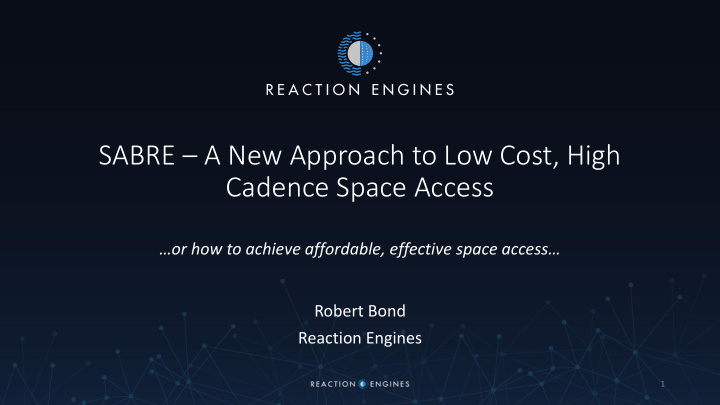



SABRE – A New Approach to Low Cost, High Cadence Space Access …or how to achieve affordable, effective space access… Robert Bond Reaction Engines 1
After 60 years of space access ….
…some amazing things have been achieved Expansion of our understanding Tangible benefits to our everyday life 3
Accessing Space – The Rocket Launch Vehicle The rocket has carried us far…however current launchers have some undesirable characteristics: • High cost • Poor operability • Low reliability …which increase the cost of space assets themselves and restrict growth of the space market …little change in launch vehicle technology in over 60 years… Today 1957 4
A Few Lessons from 60+ Years of Aircraft Evolution Kitty Hawk DH66 Hercules DC-3 Comet 4 Concorde 1903 1969 1. Breakthroughs in propulsion technology lead system evolution 2. Advantage of air-breathing propulsion 3. Horizontal operations decrease cost and increase operability 4. Reusability allows high flight rate and leads to continuous improvements 5
A Few Lessons from 60+ Years of Aircraft Evolution 1. Breakthroughs in propulsion technology lead system evolution 2. Advantage of air-breathing propulsion 3. Horizontal operations decrease cost and increase operability 4. Reusability allows high flight rate and leads to continuous improvements 6
Bringing the Aviation Model to Space Launch 1. Early launchers rapidly pushed the rocket performance boundary 2. Many new rocket-based entrants currently seeking to improve cost and operability – but achievable gains are only moderate Performance 3. New architectures and possibilities require a drastic increase in launch system propulsion performance 4. Rocket-based propulsion systems, on their own, are not able to deliver the performance required to realize a launch system with aircraft-like operability Current Propulsion Transformational Propulsion A Revolution in Launch Systems Requires a Revolution in Propulsion 7
The SABRE Engine SABRE - Synergetic ic Air r Brea eathin ing Rocket En Engin ine – is s a a ne new cla class of of en engin ine abl able to o ope operates fr from om Bypass tak ake-off to o Mach 5+ + in in air air-breathin ing mod ode, an and Burners Air Bypass to o orb orbit ital vel elocit ity in n roc ocket t mode ode Duct Air Compressor Thrust Chamber Core Thermodynamic Cycle Pre- cooler Air SABRE and and SABRE-deriv ived tec echnology has has pot potentia ial Intake app applic icatio ions to o bot both spa space ac access and and hig high-speed fl flight 8
The SABRE Engine 1. Cool 2. Regenerate 3. Integrate Cool the hot incoming air from 1000 o C Re-inject the heat captured into the Combine jet and rocket engines to in 1/20 th second (Mach 5) engine to drive the turbo-machinery, create an engine class capable of high thereby reducing fuel consumption Mach atmospheric and Space flight in a single engine 9
SABRE Performance SABRE provides improved performance over a wide speed range for thrust and efficiency compared with other propulsion systems 2 High fuel efficiency in air breathing mode up 1 to Mach 5.5 Operates from a standing start Specific Impulse (Efficiency) Engine thrust to weight 5 Step change in thrust 3 Switches to rocket mode to weight ratio when when altitude too high to switched to rocket use atmospheric air mode to power the platform into space (seconds) 0 2 4 6 8 10 0 2 4 6 8 10 4 Fuel efficiency drops to align with Mach Number Mach Number conventional rocket when switching to rocket mode as liquid oxygen has to be used instead of atmospheric air 10
Characteristics of a SABRE-based Launch System Low Cost driven by reusability and potential for high flight rate High Operability enabled by horizontal take-off and landing and other aircraft-like operations High Reliability enabled by reusability and full abort capability SpaceWorks TSTO SSTO 11
Example Mission Profile – Rapid Response TSTO Horizontal take-off from conventional runway and return to same location Air-breathing-to-rocket mode transition at Mach 5 Upper stage places satellite in selected orbit SABRE-powered booster stage o Payload: 2.5t to LEO o Vehicle GTOM: 150t 12
Example Mission Profile – Rapid Response TSTO Such a system has potential utility in: • On-demand deployment of space-based assets • Rapid reconstitution of satellite networks • Launch from multiple launch sites • ISR capability at very high altitude (>100 km) over denied areas without incursion of air-space 13
Reaction Engines • Reaction Engines Limited (REL) is a private UK company developing the SABRE advanced combined cycle air-breathing engine (Synergetic Air-Breathing Rocket Engine) • SABRE and SABRE-derived technologies have application to a variety of space access and high- speed aircraft systems • Company has raised over £100M from private and strategic investors as well as a UK government grant A Revolution in Launch Systems Requires a Revolution in Propulsion 14
SABRE Technology Development – Heat Exchangers Requirement • Cool the airflow over 700°C in 1/20 th of a second • High MW-class heat transfer Development • Manufacturing breakthrough achieved • Innovative frost control system • Extensive validation at ambient conditions • Pre-cooler testing at Mach 5 conditions in 2018 15
Recommend
More recommend